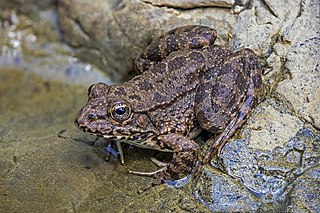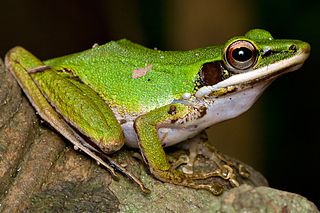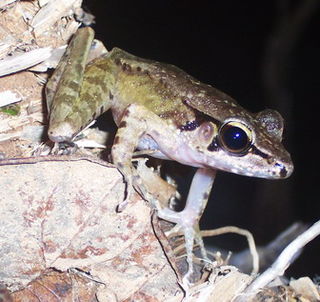
True frogs is the common name for the frog family Ranidae. They have the widest distribution of any frog family. They are abundant throughout most of the world, occurring on all continents except Antarctica. The true frogs are present in North America, northern South America, Europe, Africa, and Asia. The Asian range extends across the East Indies to New Guinea and a single species, the Australian wood frog, has spread into the far north of Australia.

Meristogenys is a genus of true frogs from Borneo. Its tadpoles are adapted to fast-flowing mountain streams and easily recognizable by their divided upper lip with ribs on the outside.

Staurois is a small genus of minuscule true frogs. Most species in the genus are restricted to Borneo, but two species are from the Philippines. This genus is a quite ancient member of the true frog family, Ranidae. They are typically found in or near rapidly flowing, small rocky streams, and are sometimes known as splash frogs or foot-flagging frogs. The latter name refers to their unusual behavior of conspicuously waving their hindlegs and feet, as a way of signalling other members of the species. Similar behavior has also been documented in other frog genera, notably Hylodes and Micrixalus.
Odorrana absita is a species of frog in the family Ranidae. It is found in southern Laos and central Vietnam. It was originally described in genus Huia. Its type locality is Xe Sap National Biodiversity Conservation Area in southern Laos.

The hole-in-the-head frog is a species of frog in the family Ranidae. It is the only member of the genus Huia. It is found on the island of Borneo. Its natural habitats are subtropical or tropical moist lowland forests, subtropical or tropical moist montane forests, and torrential rivers. It is threatened by habitat loss. The genus name honors Chinese herpetologist Shuchin Hu.
Wijayarana modiglianii is a species of frog in the family Ranidae. It is endemic to Sumatra (Indonesia). It was originally only known from two locations near Lake Toba, but is now known to be more widespread. The specific name modiglianii honors Elio Modigliani, an Italian anthropologist and zoologist who collected the holotype in 1891. Common name Modigliani's huia frog has been coined for this species. Morphological evidence suggests that it can hybridize with Huia sumatrana, but this needs confirmation using genetic data.
Meristogenys macrophthalmus is a species of frog in the family Ranidae. It is endemic to Sarawak in northern Borneo (Malaysia) and is only known from its type locality in the Bintulu District. The specific name macrophthalmus is derived from the Greek words macros (="large") and ophthalmos (="eye") and refers to the large eyes of this frog. Common names Matsui's Borneo frog, large-eyed torrent frog, and big-eyed torrent frog have been coined for it.

The common green frog is a frog species of in the true frog family Ranidae; some sources still use the old name Rana erythraea. It lives in Southeast Asia and is also known as green paddy frog, red-eared frog or leaf frog. The last name, however, commonly refers to the Neotropical tree frogs which make up the subfamily Phyllomedusinae. These are not closely related to H. erythraea, belonging to family Hylidae instead.

Humerana lateralis is a species of frog in the family Ranidae. It is found in Cambodia, Laos, Myanmar, Thailand, and Vietnam. It is commonly known as Kokarit frog, yellow frog or (ambiguously) wood frog.

Hylarana tytleri is a frog species in the family Ranidae. It is found in eastern and northeastern India, Myanmar, Bangladesh, and southern Nepal, and possibly at lower elevations in Bhutan. It was formerly placed in Rana, and included in the common green frog. It is probably a close relative of that species nonetheless, and thus placed in the revalidated genus Hylarana, of which H. erythraea is the type species. Common name Theobald's ranid frog has been coined for it, although common names for Indian frogs previously identified as Rana erythraea include yellow-striped frog, leaf frog, and leaping frog.

Polypedates colletti is a species of frog in the family Rhacophoridae. It is found in the Malay Peninsula, southern Vietnam, Borneo, Sumatra, and islands of the South China Sea.
Xenophrys lekaguli is a species of frog in the family Megophryidae. It is endemic to Southeast Asia and is known from the Chanthaburi and Sa Kaeo Provinces in eastern Thailand and from the Cardamom Mountains in Pursat Province, western Cambodia. The specific name commemorates Thai zoologist and conservationist Dr Boonsong Lekagul.
Fejervarya triora is a species of frogs belonging to the family Dicroglossidae. Its type locality is in Phu Chong-Na Yoi National Park, Ubon Ratchathani Province in the far east of Thailand. It is also known from Mukdahan National Park in Mukdahan Province, and also Pha Taem National Park, Ubon Ratchathani Province. So far, it is only known from eastern Thailand, although it is not unlikely that it occurs in adjacent Laos too. It has been found in a range of forested habitats.

Chalcorana megalonesa is a species of true frog in the family Ranidae, the "true frogs". It is endemic to Borneo and is known from both Malaysia and Indonesia (Kalimantan). It was split off from Rana chalconota in 2009 by Robert Inger and colleagues, along with a number of other species. Common name large white-lipped frog has been coined for it.

Chalcorana raniceps, also known as the copper-cheeked frog, white-lipped frog, or Peters' Malaysian frog, is a species of "true frog" in the family Ranidae. It is endemic to Borneo, including Brunei Darussalam, Kalimantan (Indonesia), and Sarawak (Malaysia), although it is likely to occur more widely. Previously mixed with Chalcorana chalconota and believed to have much wider distribution, its range was delimited to Borneo in the revision of "Rana chalconota" complex by Robert Inger and colleagues in 2009.

Sumaterana, commonly known as Sumatran cascade frogs, is a genus of true frogs in the family Ranidae endemic to the island of Sumatra, Indonesia. Species inhabit fast-flowing streams found in primary or secondary forests.

Alcalus rajae, sometimes known as king dwarf mountain frog, is a species of frog in the family Ceratobatrachidae, subfamily Alcalinae. It is endemic to Kalimantan, Borneo (Indonesia), and known from its type locality in the Bukit Baka Bukit Raya National Park, as well as the Gunung Penrissen Nature Reserve, both in the West Kalimantan province, and from the Meratus Protected Forest in the South Kalimantan province. The specific name rajae refers to the type locality: Bukit Raya is the highest mountain in Kalimantan, getting its name from the Indonesian word raya, signifying the majestic size of the peak. It also alludes to the relatively large size of this species relative to its (then) congeners.
Pulchrana fantastica, also known as the splendid stream frog, is a species of "true frog", family Ranidae. It is endemic to northern Sumatra (Indonesia) and is currently known from the Aceh and North Sumatra provinces. Its nearest relatives are Pulchrana centropeninsularis and Pulchrana siberu. The specific name fantastica is derived from the Greek phantastikós and refers to the "extraordinary beauty" of this frog.
Pulchrana centropeninsularis is a species of "true frog", family Ranidae. It is found in Peninsular Malaysia and Sumatra (Indonesia). The specific name centropeninsularis refers to the area of its original discovery, the state of Pahang in the central Peninsular Malaysia. Later on, it has also been recorded in the province of Jambi in east-central Sumatra. Pulchrana centropeninsularis is a rare species known from few individuals only. Prior to its description, Pulchrana centropeninsularis was confused with Pulchrana siberu, its closest relative.

Wijayarana is a group of true frogs found in Southeast Asia. Their common name is Wijaya cascade frogs. Many are commonly known as "torrent frogs" after their favorite habitat - small rapid-flowing mountain and hill streams -, but this name is used for many similar-looking frogs regardless of whether they are closely related.













